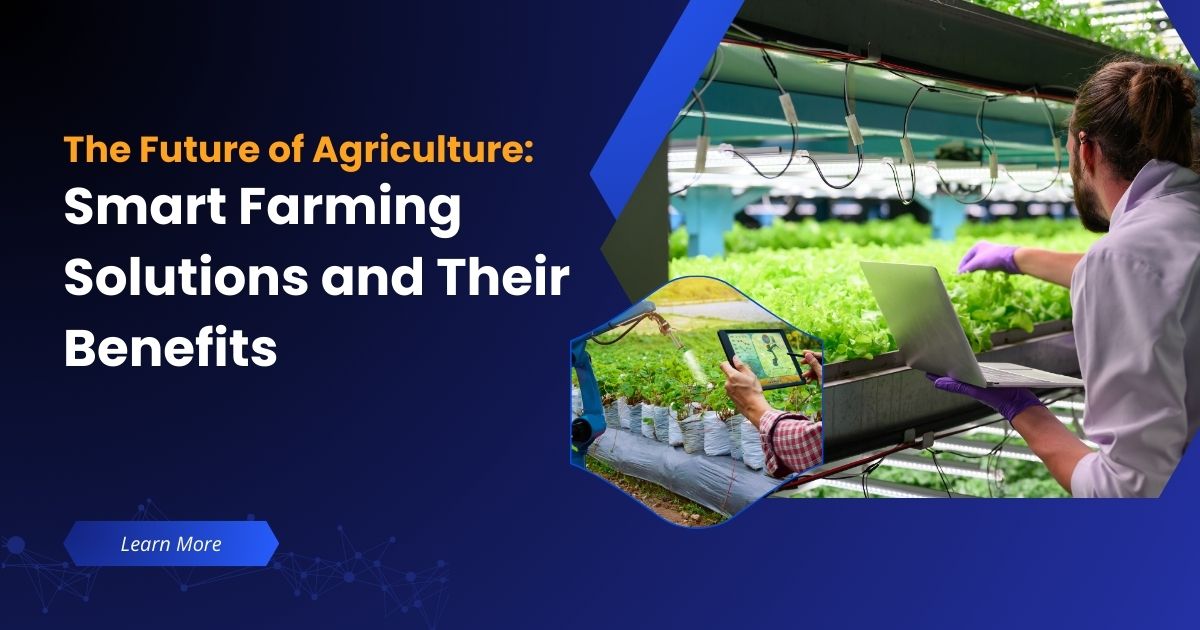The Future of Agriculture: Smart Farming Solutions and Their Benefits
The agriculture industry is undergoing a rapid transformation driven by the integration of advanced technologies. These innovations are helping farmers optimize their operations, improve efficiency, and boost crop yields. According to a report by the World Bank, smart farming technologies could increase global agricultural productivity by up to 70% by 2050. Additionally, the use of precision farming techniques is expected to save farmers $20 billion annually by reducing waste and improving resource use.
In this article, we will explore the future of agriculture, focusing on Smart Farming Solutions, the role of Smart Agriculture Solution Providers, and the many benefits these technologies bring to modern farming.
What is Smart Farming?
Smart farming refers to the application of advanced technologies in agriculture to enhance productivity, sustainability, and efficiency. This includes the use of IoT (Internet of Things) devices, sensors, drones, artificial intelligence (AI), machine learning, and data analytics to monitor, manage, and optimize farming activities.
Key Technologies Driving Smart Farming
- IoT Sensors: These devices collect real-time data on soil conditions, crop health, weather, and irrigation. This data is then analyzed to make informed decisions.
- Drones: Drones are used for aerial surveillance, crop spraying, and monitoring plant health.
- Big Data and AI: These technologies help analyze vast amounts of data to identify patterns and predict outcomes, allowing farmers to make proactive decisions.
- Automation and Robotics: Automated tractors, harvesters, and robotic systems are reducing the labor required for many tasks while increasing precision and efficiency.
Benefits of Smart Farming Solutions
The adoption of smart farming technologies offers numerous advantages, transforming traditional farming practices into more efficient, data-driven processes.
1. Improved Crop Yields
Smart farming solutions enable better monitoring and management of crop health, soil moisture, and weather conditions. With precise data, farmers can optimize irrigation, apply fertilizers more effectively, and even manage pest control with accuracy. This leads to healthier crops and, ultimately, higher yields.
Example: A farm in California implemented smart irrigation systems that use real-time weather and soil data. This resulted in a 30% reduction in water usage while increasing crop yields by 15%.
2. Resource Efficiency and Cost Savings
Smart agriculture tools enable farmers to use resources such as water, fertilizers, and pesticides more efficiently. By applying these resources only when and where they are needed, farmers can reduce waste and lower operational costs.
Example: Precision farming technology in Europe has helped farmers reduce fertilizer usage by up to 40%, cutting costs and minimizing environmental impact.
3. Sustainable Farming Practices
Sustainability is at the core of smart farming. By optimizing resource use, reducing chemical inputs, and monitoring the impact of farming activities, smart farming solutions contribute to more sustainable agricultural practices. These practices help preserve soil health, reduce water consumption, and decrease greenhouse gas emissions.
Example: A farm in the Midwest US adopted precision agriculture practices that reduced chemical pesticide use by 50%, contributing to better soil health and less environmental damage.
4. Data-Driven Decision Making
Farmers now have access to vast amounts of data that can inform their decisions. By using analytics and AI, farmers can make more accurate predictions about crop yields, pest outbreaks, and weather patterns. This leads to better planning and less risk in farm operations.
Example: A potato farm in Idaho used machine learning to predict crop yield based on weather data and soil conditions. The farm was able to adjust its planting and harvesting schedules, increasing its yield by 12%.
5. Precision Livestock Farming
Smart farming solutions aren’t just for crops. Precision livestock farming involves using technology to monitor animal health, behavior, and environmental conditions. This includes sensors that track animal movements, feeding patterns, and even early signs of illness.
Example: A dairy farm in New Zealand used IoT sensors to monitor the health and productivity of cows. This resulted in a 20% increase in milk production and a significant reduction in the number of sick cows.
How Smart Agriculture Solution Providers are Shaping the Industry
Smart Agriculture Solution Providers (SASPs) play a crucial role in developing, integrating, and supporting the technologies that drive smart farming. These companies provide a range of services, from developing sensors and AI-powered analytics platforms to offering end-to-end solutions for farmers. Here’s how they contribute:
1. Developing and Delivering Innovative Technologies
SASPs are at the forefront of technological innovation in the agricultural sector. They design and manufacture tools like drones, IoT sensors, and automated systems that are tailored to meet the unique needs of farmers. Many SASPs are also investing heavily in research and development to create new solutions that improve crop management, livestock care, and environmental sustainability.
2. Providing Software Platforms and Data Analytics
In addition to hardware solutions, SASPs offer powerful software platforms that help farmers make sense of the data collected from their farms. These platforms use AI and machine learning algorithms to provide actionable insights on crop health, soil conditions, weather forecasts, and more. This allows farmers to make informed decisions that can lead to higher productivity and lower costs.
3. Offering Customized Solutions
Every farm is different, and SASPs understand this. They offer customized solutions based on the specific needs of the farm, whether it’s large-scale commercial agriculture or smaller, family-owned farms. This level of customization ensures that farmers can get the most out of their investments in smart farming technologies.
4. Training and Support
Implementing new technology can be challenging, especially for farmers who may not be familiar with the latest innovations. SASPs provide training and ongoing support to help farmers integrate these technologies into their operations. This includes everything from technical support to hands-on training sessions and online resources.
Also Read: Sustainable Poultry Farming in Saudi Arabia: Dijla Poultry’s Green Initiatives
The Future Outlook for Smart Farming
As the agriculture industry continues to evolve, the future of smart farming looks promising. Here are some trends and predictions for the coming years:
1. Increased Adoption of AI and Machine Learning
AI and machine learning will play an even larger role in farming. These technologies will continue to evolve, providing farmers with even more accurate predictions and insights. AI will enable autonomous farming systems, such as self-driving tractors and harvesters, making farming operations more efficient.
2. Widespread Use of Drones and Robotics
Drones and robots will become increasingly common in farms around the world. They will be used for everything from crop monitoring to planting and harvesting. These technologies will reduce labor costs and improve efficiency while ensuring more precise management of agricultural tasks.
3. Expansion of Vertical Farming
Vertical farming, which involves growing crops in stacked layers or controlled indoor environments, will continue to grow. This technology allows for more efficient use of space and resources, making it a promising solution for urban farming and food production in areas with limited land.
4. Greater Focus on Sustainability and Climate Change
Sustainability will continue to be a priority for farmers and solution providers alike. Smart farming technologies will be used to minimize environmental impact, conserve water, reduce carbon emissions, and improve soil health. The focus will shift from maximizing yields at any cost to finding the most sustainable and eco-friendly methods of production.
Key Statistics in Smart Farming
| Statistic | Value |
| Global Precision Agriculture Market Size | $6.5 Billion (2021) |
| Expected Growth of Precision Agriculture Market (CAGR) | 12.2% (2021-2028) |
| Water Savings with Smart Irrigation Systems | 30-40% |
| Reduction in Pesticide Use with Precision Agriculture | 50% |
| Increase in Crop Yields with Precision Techniques | 15-25% |
Conclusion
The future of agriculture is undeniably linked to the advancement of smart farming solutions. These technologies offer immense benefits, from improving crop yields to reducing resource use and enhancing sustainability. As the industry continues to adopt new innovations, the role of Smart Agriculture Solution Providers will become even more critical in shaping the future of farming.
Farmers are no longer limited to traditional methods; they now have the tools to make data-driven decisions that lead to increased productivity, lower costs, and more sustainable practices. With continued investment in smart farming technologies, the agricultural sector will be better equipped to meet the challenges of feeding a growing global population while minimizing its environmental impact.














Post Comment